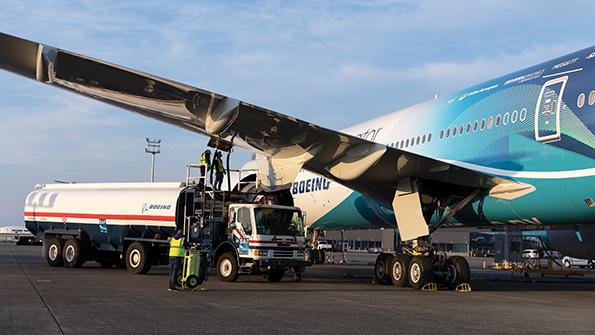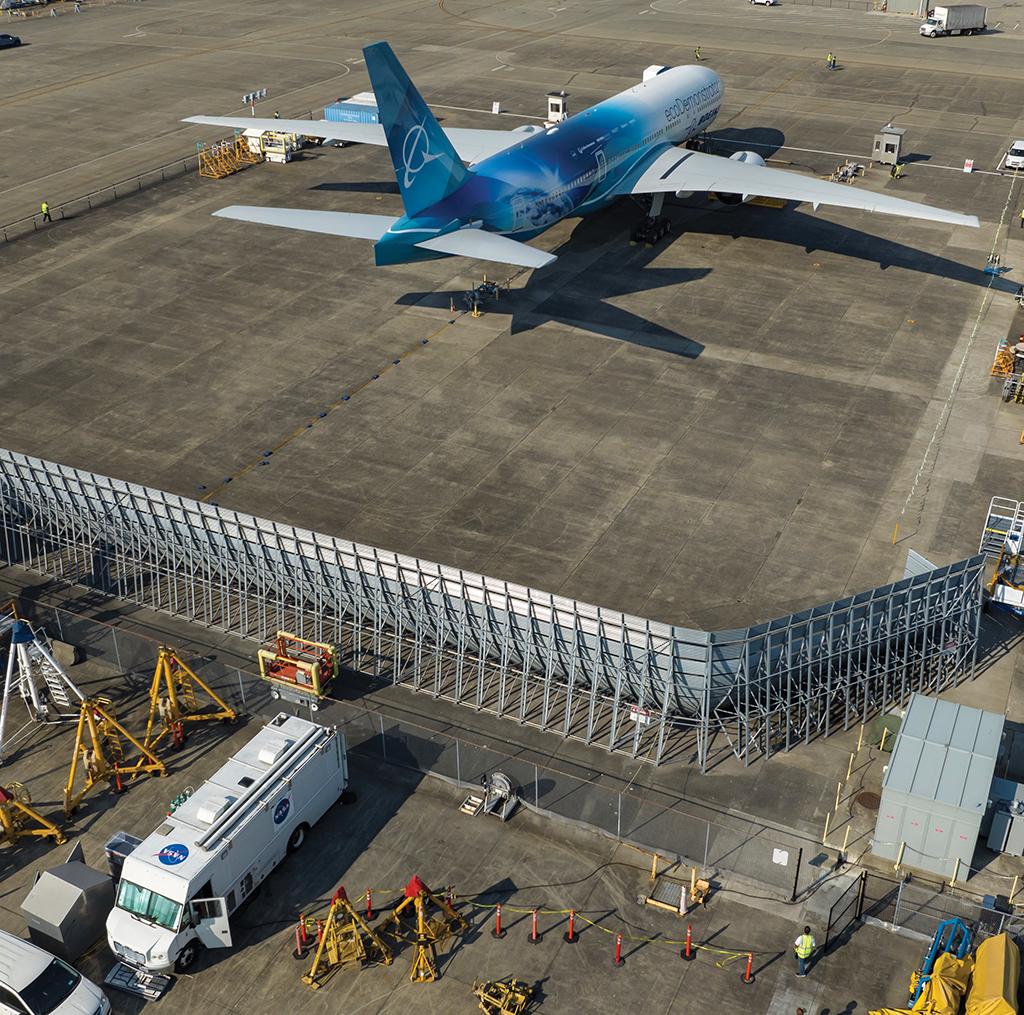
HEFA-SPK SAF fuel was loaded into a wing tank prior to the start of emissions testing.

Sustainable aviation fuel is the air transport industry’s best bet for achieving near-term decarbonization, but many unknowns remain as plans continue toward its widespread use at 100% rather than blended with current jet fuel.
Emissions characteristics of unblended sustainable aviation fuel (SAF) have not been tested yet across multiple engine types, and there are questions about the potential effect of their particulates and chemistry on contrail formation.
- Full thrust-range emissions data collected
- Lower-sulfur Jet A used for baseline tests
To learn more, researchers from NASA have joined forces with Boeing to measure emissions from SAF-powered aircraft in the manufacturer’s most recent ecoDemonstrator technology programs. Tests of a CFM International Leap 1B engine with 100% SAF on a Boeing 737-9 in 2021 showed significantly reduced soot particles, while analysis of recently completed tests on this year’s demonstrator—a Rolls-Royce Trent 800-powered 777-200ER—is still underway.
“We’re looking at different combustor technologies and using the pure fuel to understand how the emissions change across those engines,” says Rich Moore, a physical research scientist from the NASA Langley Research Center in Virginia. Using successive ecoDemonstrators, researchers for the first time measured emissions from SAF burned in the state-of-the-art low-emissions staged-combustion design in the 737’s Leap 1B and the contemporary rich-burn/quench/lean-burn (RQL) combustor of the higher-thrust Trent 800.
In addition to releasing CO2, aircraft engines burning regular fossil-based Jet A-1 emit water vapor and particles composed of volatile components such as sulfates and nitrates as well as nonvolatiles such as carbon and ash. The nonvolatile particles form in the combustor while the volatile emissions emerge in the gas phase at the engine exhaust. At cruise altitudes, the water rapidly condenses onto the particles and under the right conditions can form droplets that grow as the exhaust plume cools. These eventually freeze to form a condensation trail that in certain atmospheric conditions can persist for hours, spreading to form contrail cirrus.
However, SAF differs from conventional jet fuel in both chemical and physical properties, most notably lacking the aromatics and sulfur components that are precursors to the formation of nonvolatile and volatile particulate emissions. To quantify the makeup of the gas and particulates in the exhaust from the engine and fuel effects alone, researchers conducted multiple tests to compare traditional 100% Jet A fuel, 100% HEFA-SPK SAF (synthetic paraffinic kerosene produced via the hydroprocessed esters and fatty acids pathway) and blends of the SAF plus Jet A.
For the 2021 tests, 100% conventional Jet A kerosene was used as the reference fuel against 100% HEFA-SPK SAF and two different types of SAF: 30-70 and 50-50 blends of Seattle-area-refinery-sourced, fossil-based Jet A-1. The 30-70 blend used a commercially available SAF, while the 50-50 blend used SAF specially made for the ecoDemonstrator tests.
For this year’s trials, the fuels included a 100% HEFA-SPK SAF, 100% regular Jet A and a low-sulfur Jet A that was evaluated in the engine at 100% and as part of a 50-50 blend with SAF. The use of low-sulfur Jet A is important for establishing the true comparative basis of the emissions from the SAF in lean-burn engines, says Steve Baughcum, Boeing Emissions technical fellow.
“Soot increases if the aromatic content is higher,” Baughcum says. “And we also produce aerosols, so one of the questions is: How important is the sulfur content to the aerosols we produce? Particularly the volatile aerosols.
“We’re trying to get down into those low sulfur levels and use some of the NASA instrumentation to evaluate that,” he adds. “How do soot concentrations and volatiles interact with each other? If I have a lot of soot surface area, then I can deposit those onto the soot, and I don’t create new particles.”

For the tests, a NASA Langley mobile lab vehicle containing a suite of instruments was parked behind a jet blast deflector located aft of the 777 ecoDemonstrator. Emissions from the exhaust plume of the right (No. 2) engine burning the test fuel were fed to the instruments via a custom-built probe, which projected through the deflector. A set of spectrometers analyzed volatile and nonvolatile particle size and concentrations, while sensors provided by Massachusetts-based Aerodyne Research—including optical monitors based on the cavity attenuated phase shift technique—measured particle light-absorption and chemical composition.
“We want to understand how the emissions vary throughout the full range of the aircraft operations: from idling at the gates to taxiing to high thrust for takeoff and midthrust for cruise,” Moore says. Unlike flight tests, where only limited data can be collected from chase aircraft, “one of the beauties of doing this work on the ground is that we’re not looking at a single thrust data point or one or two points,” he adds. “We can fill out the full curve and have information and understand how the engine performs both at idle, which we care about for air quality and what’s happening around the airports, as well as the higher thrust that we care about for cruise and contrails.
“The lessons that we learn on the ground are directly translatable to what we get at cruise, and we’ve seen from past ground tests that the fuel emissions reductions associated with sustainable fuels or fuel blends directly translate to reductions in particle emissions at cruise,” Moore continues. The NASA-Boeing work also dovetails with other SAF projects such as the European ECLIF3 study involving Airbus, Rolls-Royce and German aerospace center DLR. In 2021, the project flew an Airbus A350 with both of its Trent XWB engines fueled by 100% SAF produced by Neste.
“We’re all looking at each other’s data, and we’re using the measurements that we made last year to contextualize that single data point that they have and fill in the bigger picture,” Moore says. “The hope would be, as the community moves forward, that there’ll be an opportunity to extrapolate these measurements we make on the ground up to the cruise condition.”





